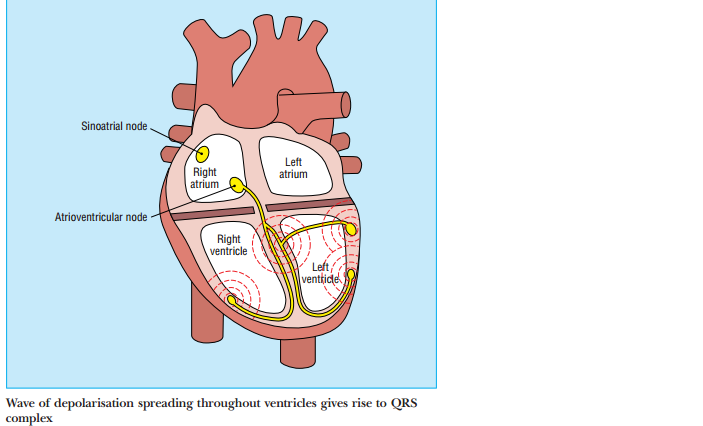| When the blood returns to the heart, it is deoxygenated. That is that blood is low in oxygen, because it’s transferred its oxygen to the tissues. | Когда кровь возвращается к сердцу, она деоксигенированная. Это когда кровь бедна кислородом, так как она передала свой кислород тканям. |
| When the blood enters the heart, it comes in through two major veins. | Когда кровь поступает в сердце, она поступает через две основные вены. |
| We have the superior [s(j)uː’pɪərɪə] vena cava and we have the inferior vena cava. | У нас есть верхняя полая вена и нижняя полая вена. |
| After passing through these two major veins, the blood enters the right atrium. | После прохождения через эти две главные вены кровь поступает в правое предсердие. |
| When the atrium contracts the blood will move through the tricuspid valve into the right ventricle. | Когда предсердие сократится, кровь будет двигаться через трехстворчатый клапан в правый желудочек. |
| When the ventricle contracts the blood will shoot up through the pulmonary semilunar valve and exit the heart through the two arteries – the left pulmonary artery and the right pulmonary artery. | Когда желудочек сократится, кровь выбросится через полулунный клапан и выйдет из сердца через две артерии – левую легочную артерию и правую легочную артерии. |
| Pulmonary refers to the lungs. So these arteries are taking the blood to the lungs – the left lung and the right lung. | «Пульмонарный» относится к легким. Т.е. эти артерии забирают кровь к легким – левому и правому легкому. |
| In the lungs, the blood will pick up oxygen and become oxygenated. So it turns red. | В легких эта кровь заберет кислород и станет оксигенированной. Т.е. станет красной. |
| The oxygenated blood will return to the heart through the left pulmonary vein and the right pulmonary vein from the left and right lung, entering the heart in the left atrium. | Эта оксигенированная кровь вернется к сердцу через левую легочную вену и правую легочную вену из левого и правого легкого, поступая в левое предсердие. |
| The atrium will contract and the blood will pass through the mitral valve into the left ventricle. | Предсердие сократится, и кровь пройдет через митральный клапан в левый желудочек. |
| The ventricle will contract and the blood will then leave the heart through the aortic semilunar valve and then enter a very large artery called the aorta. | Желудочек сократится, и кровь покинет сердце через полулунный аортальный клапан и поступит в очень крупную артерию, называемую аортой. |
| And the aorta will carry the blood downward to the lower parts of the body – the abdomen, the legs etc. And also, it will shoot the blood upward towards the head. | Аорта будет нести кровь вниз к нижним частям тела – животу, ногам и т.д. И также будет выбрасывать кровь по направлению к голове. |
| Then, after the blood has travelled through the body and given the body oxygen, then the whole process will repeat itself again. | Затем, после того как кровь прошла через тело и отдала телу кислород, весь процесс повторится снова. |
| When we look at circulation there are two major types going on here. | Когда мы смотрим на кровообращение, у нас есть два основных типа. |
| First of all, we have the circulation between the heart and the body. | Во-первых, у нас есть кровообращение между сердцем и телом. |
| If we look at it in a very general way, the blood comes in through the vena cava from the body. | Если мы посмотрим на это упрощенно (обобщенно), кровь поступает (в сердце) через полую вену от тела. |
| And, ultimately [‘ʌltɪmətlɪ], it will go out through the aorta to the body. | И, в конечном счете, она выйдет через аорту к телу. |
| And this is called the systemic circulation. | И это называется системным кровообращением (большой круг). |
| But within this process, there is another circulation, the pulmonary circulation. | Однако в этом процессе имеется еще одно кровообращение – легочное (малый круг). |
| The pulmonary circulation involves the movement of blood from the heart to the lungs, through the pulmonary arteries, and then back into the heart through the pulmonary veins. | Легочное кровообращение включает движение крови от сердца к легким через легочные артерии, и назад к сердцу через легочные вены. |
| There’s one distinction between these two types of circulation, that’s kind of important to know. | Существует одно различие между этими двумя типами кровообращения, и это важно знать. |
| When we’re talking about the systemic circulation, from the body to the heart and then back to the body, the blood coming in is low in oxygen; the blood going out is high in oxygen. | Когда мы говорим о системном кровообращении, от тела к сердцу и обратно к телу, кровь, поступающая к сердцу бедна кислородом; а кровь, выходящая из сердца, богата кислородом. |
| With pulmonary circulation, it is the exact opposite: the blood going out of the heart is low in oxygen because it’s going to the lungs to get oxygen. | Что касается легочного кровообращения, то это полная противоположность: кровь, выходящая из сердца, бедная кислородом, потому что она идет к легким, чтобы получить кислород. |
| After it got the oxygen, the blood coming into the heart is high in oxygen. | После того, как она получила кислород, кровь, поступающая в сердце, становится богатой кислородом. |
Если вам понравился урок, не забудьте подписаться на наши группы в контакте:
https://vk.com/medicine_in_english
https://vk.com/speaking_english_course
0



